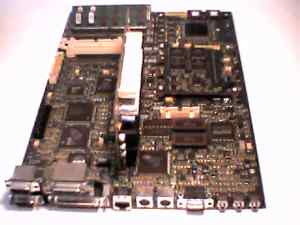I thought I would document my computer history here. It all started with a Sinclair ZX Spectrum 48K (1982), which much later got replaced by a Sinclair Spectrum Plus (the latter I did not use very much.)
The next computer was a PC-XT clone, with Intel 8088 microprocessor running at 8MHz, equipped with a rare HEGA (Hercules/EGA combo) graphics card.
While studying computer science at the University of Amsterdam, I bought the first computer with my own (not my father's) money, which was a SOYO 386DX at 33MHz. I later equipped this machine with a 387 coprocessor.
The next computer was again a PC, and again self-built from components. The processor was an Intel Pentium at 66MHz, and I remember FedEX stopping by to swap my processor with FDIV bug for a new one.
Next up, again a PC, and it was a really good deal at the bargain bin of a dealer at the HCC dagen. I bought a real multiprocessor motherboard equipped with two Pentium PRO at 200MHz. I was working at ElectroGIG at the time, and I chose it on the floating point performance which is paramount in ray tracing technology.
After ElectroGIG, I purchased a powerhouse. Pretty much the fastest processor money could buy, thanks to some funding from the Silicon Polder Fund. I bought it during a road trip to the US, from Aspen Systems in Colorado. It was a Dec Alpha based, 533MHz ev56 164LX system called Durango II.
While I was working at SARA super computer centre as a Virtual Reality specialist, one of the supers got dismantled. It was a Parsytec CC with 56 PowerPC processors. Each node was a PReP Blackhawk 603 board. Because it was capable of running Linux, the scrapped nodes were distributed to personel, and I received one. This computer was my home server for a long time.
SARA also encouraged and subsidized private computers for employees. Under the PC-Prive regeling I bought a mini laptop years ahead of its time. The Sony Vaio C1VE is more a piece of jewelry than a plain laptop, and it featured a novel CPU from Transmeta. I was following Transmeta actively at the time, as it employed my idol Linus Torvalds at the time.
After exotic architectures like DecAlpha and PowerPC, I bought another x86 PC. Shopping around I decided to get the very average-performance but attractively priced AMD Duron.
As I had my computer switched on day and night, performance was becoming less important to me, and I wanted something silent. My first attempt at HTPC was based on Via C3.
This got replaced with my second attempt at HTPC based on Mobile Pentium technology and an AOpen 915Gmm motherboard.
Tinkering with a Sony PS3 running linux got me interested in CELL SPU programming. This in turn landed me a job with SlantSix games in Vancouver. While in Vancouver I started exploring iOS and for this purchased a Mac Mini and a Macbook Air.

1 comment:
Mooi verhaal, je kunt nu wel een hardware museum beginnen,wat heb je nog nodig? ik mis trouwens de verhalen over iPad1,iPad2,iPad3,iPad mini en al die andere speeltjes.
Gewoon even met floppy drives, printers, extenders,joy sticks etc in spreadsheet zetten. Price estimates when NEW er bij en dan optellen!!!!!
Post a Comment